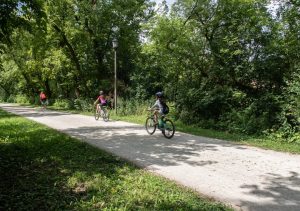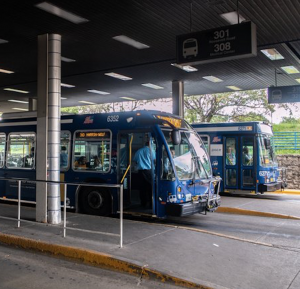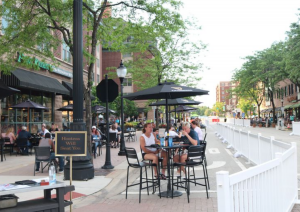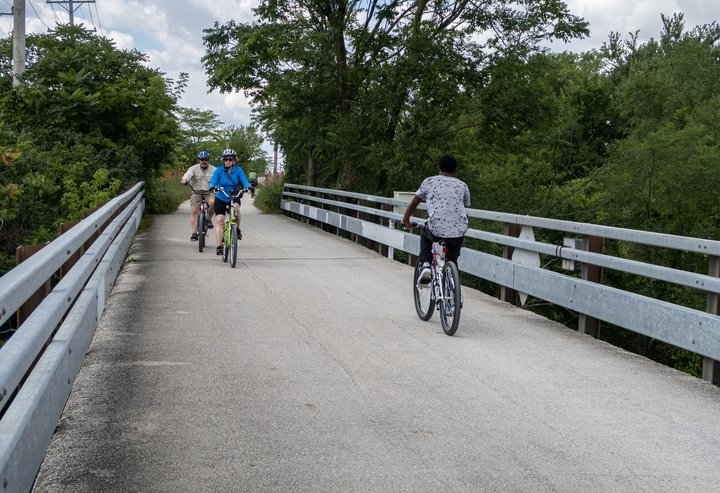The COVID-19 pandemic has changed a lot of what we perceive and know about mobility and transportation.
In recent months, Active Trans met with more than 100 stakeholders who are invested in our work. We spoke with community partners, elected officials, department of transportation and transit agency officials, and residents across the city and suburbs.
As part of this process, we held a series of small-group conversations and solo conversations with stakeholders, municipal staff, and elected officials in the north and west suburbs. Though not all encompassing, here is a glimpse of what residents are experiencing.
During the course of 14 conversations, we spoke with community members, municipal staff, and elected officials representing Des Plaines, Elgin, Highland Park, Skokie, Waukegan, DuPage County, Kane County, Kendall County, Lake County, and McHenry County (see below for the list of people we spoke with).
WALKING & BIKING
Many of the groups and individuals we spoke to in the northern and western suburbs observed an increase in people walking and biking in their community since the pandemic began. This increase in active travel was mostly recreational activity within forest preserves, trails, and on residential streets.
 Kane County Division of Transportation saw visits to trails, parks, and forest preserves more than double this spring and summer. Lake County Forest Preserve District has likewise seen an uptick in people walking and biking, with visits up by 67 percent compared to 2019.
Kane County Division of Transportation saw visits to trails, parks, and forest preserves more than double this spring and summer. Lake County Forest Preserve District has likewise seen an uptick in people walking and biking, with visits up by 67 percent compared to 2019.
Bike shops have reported a high demand in bike purchases and repairs, leading to a shortage of available bikes, both regionally and nationally.
This new interest in walking and biking highlights a critical need for a safer, connected network of pedestrian and bicycle facilities throughout the suburbs.
Similar to what we learned from our conversations with people in the south suburbs, we heard repeatedly that people cannot easily or safely get to job opportunities or essential services by foot or bike. “Hopping on your bike to buy some groceries, visit your doctor, or go to work is often not possible, even if it’s only one mile away,” one participant shared.
Busy arterial roads, high traffic speeds, and the lack of sidewalks, side paths and other facilities were noted as making walking and biking difficult. We also heard the region’s trail system generally lacks connections to destinations and is not being utilized for transportation by most people.
With many facing uncertain financial futures, low-cost and safe transportation options are needed now more than ever. These investments are especially important for the most vulnerable in our region, including older adults, people with disabilities, youth, and those without access to a car.
Solutions:
- Improve trail and park connections to downtowns, job centers, and residential areas so trails become a more viable transportation option to more people.
- With local input, create temporary, pop-up walking and biking facilities to test ideas and harness the new energy and interest in these modes.
- Examples: Temporary bike lane made of duct tape, traffic calming circle made of planters, a slow street that prioritizes walking and biking.
- See this pop-up crosswalk and pedestrian median in Skokie and Oak Park’s Slow Street Pilot.
- Invest in and implement municipal active transportation plans: “If we build parking lots for a 1-day peak parking day, why don’t we begin building our active transportation system in a way that responds to the potential of future pandemics?”
- Provide people and families new to biking with assistance and educational materials on how to bike safely in the suburbs.
TRANSIT
With more people working from home, job loss, and concerns over virus transmission, our region has seen a substantial decline in transit ridership. Several of those we spoke with in the north and west suburbs expressed concern over this ridership decline and COVID’s impacts on transit service.
“Some bus routes have been cut in our area,” one participant shared. “I worry about essential workers relying on the bus and those who don’t own a car.”
 Our state requires that at least 50 percent of operating funds for CTA, Pace, and Metra come from fares. While some federal support has allowed our bus, train, and paratransit systems to continue running despite ridership loss, if more state and federal support is not forthcoming, we may see drastic service cuts that will seriously impact our most vulnerable populations in the future.
Our state requires that at least 50 percent of operating funds for CTA, Pace, and Metra come from fares. While some federal support has allowed our bus, train, and paratransit systems to continue running despite ridership loss, if more state and federal support is not forthcoming, we may see drastic service cuts that will seriously impact our most vulnerable populations in the future.
Those using paratransit, for example, including people with disabilities and seniors, often have no other options for getting around. They rely on paratransit to get to medical appointments and to access food.
Several participants additionally shared that suburban bus service, pre- and post-COVID, is not frequent enough to meet the needs of the community.
“A lot of people here rely on the bus,” said a community partner from Waukegan. “Some land a job and have to turn it down because there’s no nearby bus line or the bus doesn’t run during second shift.”
Another lamented, “Scheduling is a big problem. Some people have to arrive at their office or school forty minutes early due to the bus schedule. If you miss the bus, you might have to wait an hour for the next one.”
Solutions:
- Invest in transit so people who rely on the bus and train can continue to access essential services in the suburbs. Take action and sign a letter to your members of Congress calling for $32 billion in COVID relief for U.S. transit agencies.
- Reevaluate the state requirement that transit agencies must collect 50 percent of their operating budget from fares. This is one of the highest fare requirements in the country and is impeding our local agencies from offering more frequent, reliable bus and train service (see our Fair Fares Chicagoland Report recommendations).
- Provide masks for all transit riders. Mask dispensers could be installed on buses and trains. The universal use of masks will help keep transit safe.
- Communicate frequently with riders. Share recommendations and reminders for safe transit riding during COVID on buses and trains, at transit stations, food banks, libraries, health centers, and other popular destinations.
MUNICIPAL BUDGETS & STAFF CAPACITY
As was noted in our south suburban research, many north and west suburban communities are also anticipating large budget cuts as a result of the pandemic.
Communities generally rely on a variety of revenue streams, including sales tax, property tax, gaming tax, vehicle fees, and motor-fuel tax, among others. In communities that heavily depend on sales tax revenue, we heard people express an interest in exploring socially-distanced outdoor dining through expanded sidewalks or closed streets.
 Since our listening tour, Arlington Heights, Batavia, Brookfield, Glen Ellyn, Lake Bluff, McHenry, St. Charles, Wheaton, and others have implemented Café Streets to help support their local businesses.
Since our listening tour, Arlington Heights, Batavia, Brookfield, Glen Ellyn, Lake Bluff, McHenry, St. Charles, Wheaton, and others have implemented Café Streets to help support their local businesses.
We also heard a mix of reports about the impact the pandemic has had on the status of capital road projects. Some communities are cutting back or delaying projects this year, while others are continuing to move projects forward. Some communities additionally reported low staff capacity siting furloughs, hiring freezes, and competing priorities.
Solutions:
- Re-evaluate 5-year capital improvements plans to improve budget outlook. With more people working from home and more people needing affordable transportation options, future investments should be shifted to walking, biking, and transit access. In additional to addressing community needs, these projects are considerably more affordable than road projects.
- As efforts continue to support local businesses, incorporate solutions that also improve walking, biking, and transit access to these areas with community input.
_______________________________
Thank you to those who took the time to speak with us about transportation, mobility needs, and creating a vision for a more resilient future. We look forward to advocating for and implementing that vision together:
- Beth Lindley, Village of Skokie
- Carrie Haberstich, Village of Skokie
- Celeste Flores, Faith in Place, Lake County
- Derek Peebles, City of Des Plaines
- Emily Daucher, McHenry County Council of Mayors, McHenry County Division of Transportation
- Jackie Forbes, Kane County Division of Transportation, Kane Kendall Council of Mayors
- Trustee Kim Stone, City of Highland Park
- Laura Rios, Waukegan to College
- Parker Thompson, Elgin Bike Hub
- Ryan Peterson, Kane County Division of Transportation, Kane Kendall Council of Mayors
- Scott Hennings, McHenry County Division of Transportation
- Sid Kenyon, DuPage County Division of Transportation
- Tameeca Russell, Urban Muslim Minority Alliance
- Yadira Chuc, Waukegan to College
Be sure to read the companion blog posts featuring the South Suburbs and Chicago’s North Side, West Side, Southwest Side, and South Side.
Cafe Street photo courtesy of Elizabeth Owens-Schiele / Pioneer Press.

